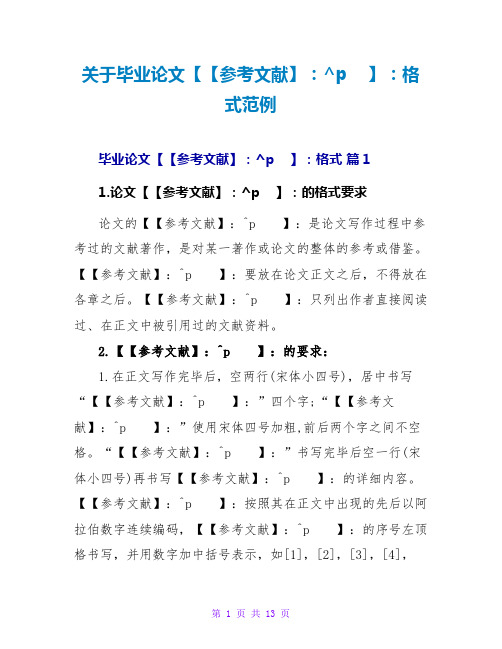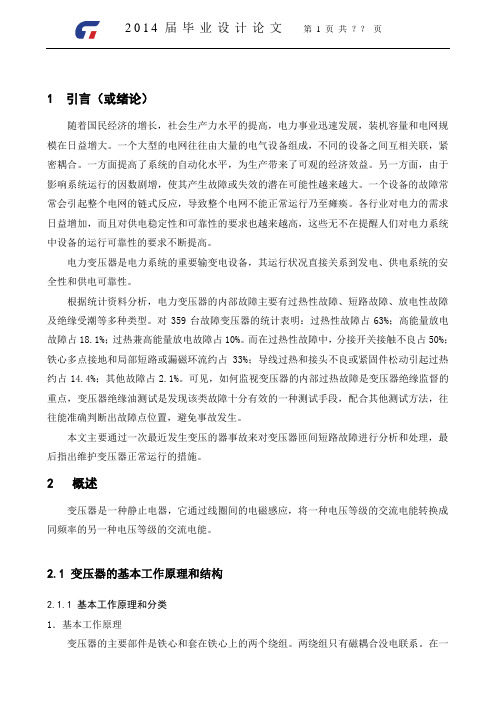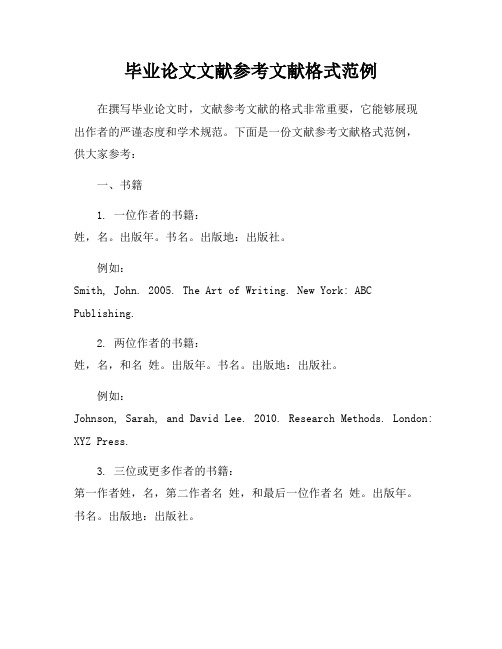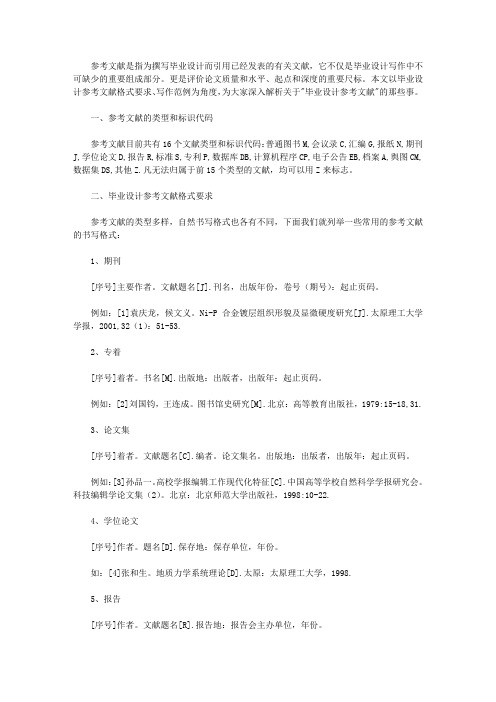毕设论文(样例)3 正文+参考文献
毕业论文参考文献标注格式[五篇范例]
![毕业论文参考文献标注格式[五篇范例]](https://img.taocdn.com/s3/m/fe23c42ac4da50e2524de518964bcf84b9d52dfb.png)
毕业论文参考文献标注格式[五篇范例]第一篇:毕业论文参考文献标注格式一、参考文献的类型参考文献(即引文出处)的类型以单字母方式标识,具体如下:M——专著C——论文集N——报纸文章J——期刊文章D——学位论文R——报告对于不属于上述的文献类型,采用字母―Z‖标识。
对于英文参考文献,还应注意以下两点:①作者姓名采用―姓在前名在后‖原则,具体格式是:姓,名字的首字母.如: Malcolm Richard Cowley 应为:Cowley, M.R.,如果有两位作者,第一位作者方式不变,&之后第二位作者名字的首字母放在前面,姓放在后面,如:Frank Norris 与Irving Gordon应为:Norris, F.& I.Gordon.;②书名、报刊名使用斜体字,如:Mastering English Literature,English Weekly。
二、参考文献的格式及举例 1.期刊类【格式】[序号]作者.篇名[J].刊名,出版年份,卷号(期号):起止页码.【举例】[1] 王海粟.浅议会计信息披露模式[J].财政研究,2004,21(1):56-58.[2] 夏鲁惠.高等学校毕业论文教学情况调研报告[J].高等理科教育,2004(1):46-52.[3] Heider, E.R.& D.C.Oliver.The structure of color space in naming and memory of two languages [J].Foreign Language Teaching and Research, 1999,(3): 62 – 67.2.专著类【格式】[序号]作者.书名[M].出版地:出版社,出版年份:起止页码.【举例】[4] 葛家澍,林志军.现代西方财务会计理论[M].厦门:厦门大学出版社,2001:42.[5] Gill, R.Mastering English Literature [M].London: Macmillan, 1985: 42-45.3.报纸类【格式】[序号]作者.篇名[N].报纸名,出版日期(版次).【举例】[6] 李大伦.经济全球化的重要性[N].光明日报,1998-12-27(3).[7] French, W.Between Silences: A Voice from China[N].Atlantic Weekly, 1987-8-15(33).4.论文集【格式】[序号]作者.篇名[C].出版地:出版者,出版年份:起始页码.【举例】[8] 伍蠡甫.西方文论选[C].上海:上海译文出版社,1979:12-17.[9] Spivak,G.―Can the Subaltern Speak?‖[A].In C.Nelson & L.Grossberg(eds.).Victory in Limbo: Imigism [C].Urbana: University of Illinois Press, 1988, pp.271-313.[10] Almarza, G.G.Student foreign language teacher’s knowledge growth [A].In D.Freeman and J.C.Richards(eds.).Teacher Learning in Language Teaching [C].New York: Cambridge University Press.1996.pp.50-78.5.学位论文【格式】[序号]作者.篇名[D].出版地:保存者,出版年份:起始页码.【举例】[11] 张筑生.微分半动力系统的不变集[D].北京:北京大学数学系数学研究所, 1983:1-7.6.研究报告【格式】[序号]作者.篇名[R].出版地:出版者,出版年份:起始页码.【举例】[12] 冯西桥.核反应堆压力管道与压力容器的LBB分析[R].北京:清华大学核能技术设计研究院, 1997:9-10.7.条例【格式】[序号]颁布单位.条例名称.发布日期【举例】[15] 中华人民共和国科学技术委员会.科学技术期刊管理办法[Z].1991—06—05 8.译著【格式】[序号]原著作者.书名[M].译者,译.出版地:出版社,出版年份:起止页码.三、注释注释是对论文正文中某一特定内容的进一步解释或补充说明。
最新建筑毕业论文参考文献范文(3篇)【范本模板】

最新建筑毕业论文参考文献范文(3篇)最新建筑毕业论文参考文献范文(一)Nor Berg-Schulz,场所精神迈向建筑现象学[M],华中科技大学出版社,2012;杨、盖尔,交往与空间[M],北京:中国建筑工业出版社,2002;K。
Lynch,城市意向[M],北京:华夏出版社,2001;童林旭,地下空间与城市现代化发展,北京:中国建筑工业出版社,2005;刘晓晖、杨宇振,商业建筑[M],武汉:武汉大学出版社,1999;曾坚、陈岚、陈志宏。
,现代商业建筑的规划与设计[M],天津:天津大学出版社,2002;杨贵庆,城市社会心理学[[M],上海:同济大学出版社,2000;布恩(美),心理学原理和应用[M],知识出版社,1985;魏伦杰,张卫华,关注城市地下商业建筑的安全性与舒适性[J]。
四川建筑,2007 年第 27 卷;I. L. Mcharg,设计结合自然[M],北京:中国建筑工业出版社,1992;高履泰,光环境的剖析,北京建筑工程学院.照明工程学报 200(04);王紫雯、涂银霞,城市居住环境中的人文要素研究以杭州市的人居环境调查为例,建筑学报,2002。
1. p40;韩晶,张宇星,城市流线空间连续性设计的方法.规划师,2004, 09 : 90—93;童林旭,地下空间概论,地下空间,2004 年 3 月,24 (1):133—142;童林旭,地下空间与未来城市,地下空间与工程学报,2005 年 06 月,1 (3 ) : 323-328;束昱、彭方乐,地下空间研究的新领域一一地下环境心理学、地下空间,1990,1(3);王保勇,束昱,影响城市地下空间环境的因素分析,同济大学学报,2000,28(6) : 656—660;陈秋琼,改善室内空气环境的几种方法,上海建设科技,2000,03;[美]吉迪恩、S、格兰尼,[日]尾岛俊雄.城市地下空间设计,北京:中国建筑工业出版赵景伟,城市化进程中的人居环境与地下空间利用.隧道建设,2008,28 (2); 154-157;陈育霞,诺伯格、舒尔茨的场所和场所精神理论及其批判,长安大学学报,2003,2(4);30—33;郭红、莫鑫,诺伯格、舒尔茨的场所理论评析,四川建筑,204, 24 (5);胡映东,场所精神的回归,山西建筑,2007,33(18): 26-27;费彦,现象学与场所精神,武汉城市建设学院学报,1999,16(4);25. 李道增,环境行为学概论[M],北京:清华大学出版社,1999;刘力,商业建筑[M],北京:中国建筑工业出版社,1999;(丹)扬、盖尔、拉尔斯、吉姆松,公共空间、公共生活[M],北京:中国建筑工业出版社,2003;赵慧宁、赵军,现代商业环境设计与分析[M],南京:东南大学出版社,2005;鲁睿,商业空间设计 [M],北京:知识产权出版社,2006;张伟.,商业建筑[M],北京:中国建筑工业出版社,2006;最新建筑毕业论文参考文献范文(二)Nor Berg-Schulz,场所精神迈向建筑现象学[M],华中科技大学出版社,2012;杨、盖尔,交往与空间[M],北京:中国建筑工业出版社,2002;K. Lynch,城市意向[M],北京:华夏出版社,2001;童林旭,地下空间与城市现代化发展,北京:中国建筑工业出版社,2005;刘晓晖、杨宇振,商业建筑[M],武汉:武汉大学出版社,1999;曾坚、陈岚、陈志宏。
毕业论文参考文献格式范例

关于毕业论文【【参考文献】:^p 】:格式范例毕业论文【【参考文献】:^p 】:格式篇11.论文【【参考文献】:^p 】:的格式要求论文的【【参考文献】:^p 】:是论文写作过程中参考过的文献著作,是对某一著作或论文的整体的参考或借鉴。
【【参考文献】:^p 】:要放在论文正文之后,不得放在各章之后。
【【参考文献】:^p 】:只列出作者直接阅读过、在正文中被引用过的文献资料。
2.【【参考文献】:^p 】:的要求:1.在正文写作完毕后,空两行(宋体小四号),居中书写“【【参考文献】:^p 】:”四个字;“【【参考文献】:^p 】:”使用宋体四号加粗,前后两个字之间不空格。
“【【参考文献】:^p 】:”书写完毕后空一行(宋体小四号)再书写【【参考文献】:^p 】:的详细内容。
【【参考文献】:^p 】:按照其在正文中出现的先后以阿拉伯数字连续编码,【【参考文献】:^p 】:的序号左顶格书写,并用数字加中括号表示,如[1],[2],[3],[4],[5]…,每一【【参考文献】:^p 】:条目的最后均以英文句号“.”完毕。
2.【【参考文献】:^p 】:只列出作者已直接阅读、在撰写论文过程中主要参考过的文献资料,所列【【参考文献】:^p 】:应按论文参考的先后顺序排列。
【【参考文献】:^p 】:与正文连续编排页码。
【【参考文献】:^p 】:不少于6篇。
3.【【参考文献】:^p 】:格式【【参考文献】:^p 】:类型及文献类型,根据GB3469-83《文献类型与文献载体代码》规定,以单字母方式标识:(1)专著:〔序号]作者.专著名[M].出版地:出版社,出版年.(2)期刊中析出的.文献:〔序号]作者.题(篇)名[J].刊名,出版年 (期号).(3)论文集:〔序号]作者.题(篇)名[C]. 出版地:出版社,出版年.(4)学位论文:〔序号]作者.题(篇)名[D].授学位地:授学位单位,授学位年.(5)专利文献:〔序号]专利申请者.专利题名[P].专利国别:专利号,出版日期.(6)报纸文章:〔序号]作者.题(篇)名[N].报纸名,出版日期.(7)电子文档:〔序号]作者.题(篇)名〔文献类型/载体类型〕.网址,发表日期.关于【【参考文献】:^p 】:的未尽事项可参见国家标准《文后【【参考文献】:^p 】:著录规那么》(GB/T7714-2023)。
样例:福州大学本科生毕业设计(论文)参考文献格式

参考文献格式参考文献一律放在文后,参考文献的书写格式要按国家标准GB7714-87《文后参考文献著录规则》规定。
参考文献按文中出现的先后统一用阿拉伯数字进行自然编号,一般序码宜用方括号括起,不用园括号括起。
对作者已阅读过的对论文具有参考价值的文献应尽可能列出,并按文中引用文献出现的先后顺序连续编号。
引用文献标示应置于所引内容的末尾的右上角,编号用阿拉伯数字并加上方括号,如“网络的先进性--[4]”。
当在文中直接提及参考文献时,其编号应与正文排齐,如“由参考文献[9,20-21]可知”。
不得将引用文献标示置于各级标题上。
参考文献表根据下述格式书写,并按顺序编号,即按文中引用的顺序将参考文献附于文末。
作者姓名写到第三位,余者写“,等”或“,et al.”。
几种常见参考文献著录表的格式为:连续出版物:[序号] 作者.文题.刊名,年,卷号(期号):起~止页码专(译)著:[序号] 作者.书名(,译者).出版地:出版者,出版年.起~止页码论文集:[序号] 作者.文题.见(in):编者,编(eds.).文集名.出版地:出版者,出版年.起~止页码学位论文:[序号] 姓名.文题:[XX学位论文].授予单位所在地:授予单位,授予年专利:[序号] 申请者.专利名.国名,专利文献种类,专利号,出版日期技术标准:[序号] 发布单位.技术标准代号.技术标准名称.出版地:出版者,出版日期电子文献:[序号]主要责任者.电子文献题名.电子文献的出版或可获得地址,发表或更新的期/引用日期(任选).举例如下:[1] 张昆,冯立群,余昌钰,等.机器人柔性手腕的球面齿轮设计研究.清华大学学报,1994,34(2):1-7 .[2] 竺可桢.物理学.北京:科学出版社,1973.56-60.[3] Dupont B. Bone marrow transplantation in severe combined immunodeficiency with an unrelated MLC compatible donor.In:White H J, Smith R, eds. Proceedings ofthe Third Annual Meeting ofthe International Society for Experimental Hematology.Houston:International Society for Experimental Hematology,1974.44-46.[4] 郑开青.通讯系统模拟及软件:[硕士学位论文].北京:清华大学无线电系,1987.[5] 姜锡洲.一种温热外敷药制备方法.中国专利,881056073,1980-07-26.[6] 中华人民共和国国家技术监督局. GB3100~3102.中华人民共和国国家标准——量与单位. 中国标准出版社, 1994-11-01.[21] 王明亮.中国学术期刊标准化数据库系统工程的./pub/wml.txt/9808 10-2.html,1998-08-16/1998-10-04.。
论文(正文及参考文献)示例

在市场竞争日趋激烈的当今社会,企业要生存、发展,已离不开内部控制。
我国企业的内部控制起步较晚,经过十几年的发展,虽有一定的成绩,但与发达国家相比,仍Array有明显的差距。
目前,……一、公司概况二、公司内部控制现状“内部控制”一词首次提出是在上个世纪30年代,经过注入了许多新的内容。
按照COSO 报告的定义,“内部控制是…………”。
在现代企业中,其主要作用如下:企业是由各个部门或者各个职能单位和业务部门组成的整体,为保证各单位的活动服务于企业整体目标,就需要进行全面的协调,以便于各个组成部分能够相互配合。
1.(1①内部制约2.…… ……(三)反映和监督作用内部控制发挥作用的很多方面是依靠会计信息的反映和监督来完成的。
预算完成的好坏,各项控制指标的执行情况等都必须通过及时、可靠的会计信息予以反映,可以说对经营过程的正确反映,以及对控制目标的完成状况和各部分行为是否偏离内部控制的要求等的事后检查和监督也是内部控制的一个重要作用。
通过反映和监督,能及时调整不利的行为,有利于企业高层领导做出正确的决策并采取有效的措施,保证内部控制目标的实现。
三、公司内部控制制度缺陷2002年正式成立。
公司现-乌鲁木齐的货运专线,员工近百人。
公司设有为了满足业务经营的需要,企业不断的扩大规模,与此同时,京铁环海物流的内部控制存(一)内部控制意识淡薄控制环境不完善COSO报告认为,控制环境是指对建立、加强或削弱特定政策、程序及其效率产生影响的各种因素,具体包括企业的董事会、企业管理人员的品行操守、价值观、素质与能力、管理人员的管理哲学与经营观念,企业文化,企业各项规章制度、信息沟通体系等。
………四、对建立和完善企业内部控制的意见内部控制应与企业的经营管理相结合,完善的内部控制可以提高企业经营活动的效率和效果。
保证会计信息的真实和完整并遵循国家的法概念的影响,其外延非常广泛,内涵也相当复杂,不过其核心仍是企业社会责任[1]。
周俭节变压器毕业设计论文(论文)正文、结论、致谢、参考文献 3

1 引言(或绪论)随着国民经济的增长,社会生产力水平的提高,电力事业迅速发展,装机容量和电网规模在日益增大。
一个大型的电网往往由大量的电气设备组成,不同的设备之间互相关联,紧密耦合。
一方面提高了系统的自动化水平,为生产带来了可观的经济效益。
另一方面,由于影响系统运行的因数剧增,使其产生故障或失效的潜在可能性越来越大。
一个设备的故障常常会引起整个电网的链式反应,导致整个电网不能正常运行乃至瘫痪。
各行业对电力的需求日益增加,而且对供电稳定性和可靠性的要求也越来越高,这些无不在提醒人们对电力系统中设备的运行可靠性的要求不断提高。
电力变压器是电力系统的重要输变电设备,其运行状况直接关系到发电、供电系统的安全性和供电可靠性。
根据统计资料分析,电力变压器的内部故障主要有过热性故障、短路故障、放电性故障及绝缘受潮等多种类型。
对359台故障变压器的统计表明:过热性故障占63%;高能量放电故障占18.1%;过热兼高能量放电故障占10%。
而在过热性故障中,分接开关接触不良占50%;铁心多点接地和局部短路或漏磁环流约占33%;导线过热和接头不良或紧固件松动引起过热约占14.4%;其他故障占2.1%。
可见,如何监视变压器的内部过热故障是变压器绝缘监督的重点,变压器绝缘油测试是发现该类故障十分有效的一种测试手段,配合其他测试方法,往往能准确判断出故障点位置,避免事故发生。
本文主要通过一次最近发生变压的器事故来对变压器匝间短路故障进行分析和处理,最后指出维护变压器正常运行的措施。
2 概述变压器是一种静止电器,它通过线圈间的电磁感应,将一种电压等级的交流电能转换成同频率的另一种电压等级的交流电能。
2.1 变压器的基本工作原理和结构2.1.1 基本工作原理和分类1.基本工作原理变压器的主要部件是铁心和套在铁心上的两个绕组。
两绕组只有磁耦合没电联系。
在一次绕组中加上交变电压,产生交链一、二次绕组的交变磁通,在两绕组中分别感应电动势。
毕业论文文献参考文献格式范例

毕业论文文献参考文献格式范例在撰写毕业论文时,文献参考文献的格式非常重要,它能够展现出作者的严谨态度和学术规范。
下面是一份文献参考文献格式范例,供大家参考:一、书籍1. 一位作者的书籍:姓,名。
出版年。
书名。
出版地:出版社。
例如:Smith, John. 2005. The Art of Writing. New York: ABC Publishing.2. 两位作者的书籍:姓,名,和名姓。
出版年。
书名。
出版地:出版社。
例如:Johnson, Sarah, and David Lee. 2010. Research Methods. London: XYZ Press.3. 三位或更多作者的书籍:第一作者姓,名,第二作者名姓,和最后一位作者名姓。
出版年。
书名。
出版地:出版社。
例如:Brown, Michael, Jennifer White, and Robert Davis. 2018. Economics in the 21st Century. Boston: LMN Publications.二、期刊文章1. 一位作者的期刊文章:姓,名。
出版年。
"文章标题." 期刊名,卷号(期号):页码。
例如:Miller, Emily. 2013. "The Impact of Climate Change on Agriculture." Journal of Environmental Studies 25(3): 45-58.2. 两位作者的期刊文章:姓,名,和名姓。
出版年。
"文章标题." 期刊名,卷号(期号):页码。
例如:Clark, Robert, and Lisa Johnson. 2016. "Gender Equality inthe Workplace." Gender Studies Quarterly 12(2): 78-91.三、网页1. 网页文章:作者(如果有)。
大学生毕业论文参考文献(精选5篇)

大学生毕业论文参考文献(精选5篇)第一篇:大学生毕业论文参考文献大学生毕业论文参考文献时间稍纵即逝,充满意义的大学生活即将结束,大家都知道毕业生要通过毕业论文,毕业论文是一种有准备、有计划的检验学生学习成果的形式,那么什么样的毕业论文才是好的.呢?下面是小编整理的大学生毕业论文参考文献,欢迎大家分享。
大学生毕业论文参考文献1[1] 肖玲,余瑶.武汉汉口江滩公园现状分析与问题研究[J].科技致富向导.2012(26)[2] 刘保艳.汉口江滩公园风景体验研究[D].华中农业大学 2014[3] 谢阳.城市内河景观生态规划治理研究[D].中南林业科技大学2014[4] 张得宁.祁连山地区小流域生态景观林建植与生态抚育技术研究[D].西北农林科技大学 2014[5] 王琳琳.废弃采石场植被恢复设计标准与景观研究[D].南京农业大学 2012[6] 戚维隆,郗金标,张建华.上海外滩滨水区改造景观效果分析探讨[J].经济研究导刊.2011(09)[7] 卞世卉.景观工程施工项目质量控制要点分析[J].现代农业科学.2008(11)[8] 邵云南.剑麻纤维水泥混凝土(路面)配合比试验研究[D].武汉工程大学 2014[9] 王伟.杭瑞高速公路湖北段生态景观恢复模式研究[D].武汉工程大学 2014[10] 赵明雨.蓄滞洪区一二维多口门衔接洪水调度数学模型研究与应用[D].天津大学 2014[11] 蔡美营.蓄滞洪区洪水特性对地面沉降的响应研究[D].天津大学 2014[12] 李玉刚.甘肃省泾川县合志沟山洪灾害堤防工程治理措施研究[D].甘肃农业大学 2014[13] 周星.武汉三环线五座桥梁养护管理研究[D].武汉工程大学2014[14] SL 223-1999.水利水电建设工程验收规程[S].1999[15] 林家辉.探讨如何实现新旧建筑的完美结合[J].建材与装饰(下旬刊).2007(10)[16] 詹美旭,葛幼松.莫愁湖滨水景观变迁影响因素研究[J].安徽农业科学.2007(25)[17] 傅熹年.中国古代建筑外观设计手法初探[J].文物.2001(01)[18] Paul Davidoff.ADVOCACY AND PLURALISM IN PLANNING[J].Journal of the American Planning Association.1965(4)大学生毕业论文参考文献2[1]Ronald WRebore.Human Resources Administration in Education(6th Edition)[M].Boston:Allyn & Bacon,Pearson Education, Inc.,2001[2]C Chadwick, P Cappelli.Alternative to Generic Strategy Typologies in Strategic Human Resource Management[M].Greenwich, Ct: JAI Press, 1999[3]宋本江胡跃福:人才招聘,另请高明还是自己培养[J].中国人才,2003(8)[4]丁敬平:向跨国公司学习什么[J].中国企业家,2005(11)[5]程桢贾雅军:企业内部人才资源的运用[J].经济问题,2004(11)[6]安鸿章:企业人才聘任的两种模式[J].中国人才,2002(4)[1]亚瑟W小舍曼:乔治W勃兰德·斯科特A斯奈尔著张文贤主译:人力资源管理.东北财经大学出版社,2001[2]魏峰李赕张文贤:国内外心理契约研究的新进展.管理科学学报,2005(10)[3]陈加洲:凌文辁&方俐洛.组织中的心理契约,管理科学学报,2001,4(2)[4]陈加洲凌文辁·方俐洛:企业员工心理契约的结构维度.心理学报, 2003,35(3)大学生毕业论文参考文献3[1]王刚编著:《把握好用人的技巧与管人的学问》.地震出版社,2003年2月[2]斯蒂芬·P·罗宾斯著:《管人的真理》.中信出版社,2002年9月[3]李诚主编:《人力资源管理的12堂课》.中信出版社,2002年11月[4]吴志明著:《员工招聘与选拔实务手册.机械工业出版社,2002年1月[5]赵曙明:《人力资源管理研究》.中国人民大学出版社,2001年[6]詹姆斯.W.沃克:《人力资源战略》.中国人民大学出版社,2001年1月[7]罗布.戈菲:《人员管理》.中国人民大学出版社,2001年01月第二篇:大学生毕业论文文献综述题目名称在高校体育教学中实施心理健康教育的研究题目类别毕业论文学院(系)体育学院/体育教育系专业班级2003,23(1):18-21[15]熊亚红,等.大学生心理健康状况与体育教学模式的探讨[J].现代教育科学,2005,(5):73-75[16]熊亚红,等.大学生心理健康状况与体育教学模式的探讨[J].现代教育科学,2005,(5):73-75[17]侯世勋,等.高校体育课加强心理健康教育之探讨[J].洛阳师范学院学报,2002,(5):110-102[18]刘卫民,李平.体育教学中实施心理健康教育论纲[J],湖北师范学院学报(自然科学版),2003,23(1):18-21[19]熊亚红,等.大学生心理健康状况与体育教学模式的探讨[J].现代教育科学,2005,(5):73-75 073021班学生姓名指导教师辅导在高校体育教学中实施心理健康教育的研究学生:体育学院指导老师:体育学院(长江大学体育学院湖北荆州 434020)[前言]大学生心理问题发生的频率加快、范围加大和程度加深。
毕业设计正文、结论、参考文献

(可作为正文第1章标题,用小3号黑体,加粗,0.5行,段后0.5行)×××××××××(小4号宋体,1.25--1.5倍行距)×××××××××××××××××××××………1.1 ××××××(作为正文2级标题,用4号黑体,加粗)×××××××××(小4号宋体)××××××…………1.1.1 ××××(作为正文3级标题,用小4号黑体,不加粗)×××××××××(小4号宋体)×××××××××××××××××××××××××××………2 ×××××××(作为正文第2章标题,用小3号黑体,加粗,并留出上下间距为:段前0.5行,段后0.5行)×××××××××(小4号宋体)×××××××××××××××××××××××××××××××××××………注:1.正文中表格与插图的字体一律用5号宋体;2.正文各页的格式请以此页为标准复制,页眉中的页码用阿拉伯数字表示(本文档的页码已设置成自动格式);3.为保证打印效果,学生在打印前,请将全文字体的颜色统一设置成黑色。
《毕业论文文献文献综述模板与范文参考》

《毕业论文文献文献综述模板与范文参考》毕业论文文献综述模板与范文参考一、引言在撰写毕业论文时,文献综述是一个非常重要的部分,它不仅可以展示研究者对相关领域已有研究成果的了解,还可以为研究提供理论支持和研究思路。
因此,如何撰写一篇完整、系统的文献综述成为许多学生关注的焦点。
本文将介绍毕业论文文献综述的模板结构,并提供一篇范文供参考。
二、文献综述模板结构1. 研究背景在文献综述的开头部分,应该明确阐述研究的背景和意义,引出研究的主题。
可以从研究领域的发展历程、研究现状和存在的问题等方面入手,引出研究的价值和必要性。
2. 文献综述接下来,对相关领域的文献进行综述。
可以按照时间顺序、主题分类或研究方法等方式组织文献,对已有研究成果进行梳理和总结。
需要注意的是,文献综述不是简单地列举文献,而是要对文献进行分析和评价,指出各篇文献的优缺点和不足之处。
3. 研究方法在文献综述的结尾部分,可以简要介绍研究方法。
包括研究设计、样本选择、数据收集和分析方法等内容。
这部分内容可以为后续研究提供参考,展示研究的可行性和科学性。
4. 结论与展望最后,对文献综述进行总结,指出已有研究的不足之处和未来研究的方向。
可以展望研究的发展趋势和潜在的研究价值,为后续研究提供启示。
三、文献综述范文参考(以下为范文部分,仅供参考)研究背景随着互联网的快速发展,电子商务在全球范围内得到了广泛的应用。
电子商务平台作为电子商务的重要载体,对于促进商品交易、信息传播和消费者互动起着至关重要的作用。
然而,随着电子商务平台的不断增多和竞争的加剧,如何提升电子商务平台的用户体验成为了一个亟待解决的问题。
文献综述在过去的研究中,学者们对电子商务平台的用户体验进行了广泛的探讨。
Smith等(2010)通过实证研究发现,用户体验对于电子商务平台的用户满意度和忠诚度有着显著的影响。
Jones(2012)则从用户界面设计的角度出发,提出了提升用户体验的策略和方法。
毕业论文参考文献模板

毕业论文参考文献模板参考文献模板(700字)参考文献模板是毕业论文中非常重要的一部分,它用于列举毕业论文中所引用的文献和资料,以方便读者查阅和验证论文中的观点和结论。
下面是一个参考文献模板的示例:【中文文献】1. 作者姓名. 文章标题. 期刊名称,年份,卷(期):起止页码.例如:[1] 张三,李四,王五. 留学生英语写作现状与对策研究. 外语教育与研究,2018,(4): 10-15.2. 作者姓名. 书名. 出版地:出版社,年份.例如:[2] 张三. 英语写作指导手册. 北京:外语教学与研究出版社,2017.3. 作者姓名. 论文名称. [类型/程度]. 所在学校,年份.例如:[3] 张三. 跨文化交际视角下的英语写作教学研究. [硕士论文]. 北京外国语大学,2019.【英文文献】1. Author(s) Last Name, First Initial(s). Title of Article. Journal Name, Year, Volume(Issue):Page Range.例如:[1] Smith, J, Johnson, A. A Study of English Writing Strategies of Chinese ESL Postgraduates. Journal of Language Teaching and Research, 2018, 9(4): 834-840.2. Author(s) Last Name, First Initial(s). Title of Book. Place of Publication: Publisher, Year.例如:[2] Smith, J. A Guide to English Writing. Beijing: Foreign Language Teaching and Research Press, 2017.3. Author(s) Last Name, First Initial(s). Title of Thesis.[Type/Degree]. Name of University, Year.例如:[3] Smith, J. A Study on English Writing Teaching from a Cross-cultural Communication Perspective. [Master's thesis]. Beijing Foreign Studies University, 2019.参考文献模板提供了一种标准格式,可以让毕业论文的作者在列举参考文献时保持一致性,从而提高论文的质量和可读性。
毕业论文参考文献范例_论文格式_

毕业论文参考文献范例小编为您提供一篇关于参考文献范例,欢迎浏览![1] 水利工程建设对生态环境的影响分析研究吕天群科技资讯- XX 年15 期.[2] 浅谈水利工程与生态环境的影响及措施陈新永江苏环境科技- XX 年01期.[3] 浅议水利工程建设期的环境保护措施陈刚[1] 戴凤霞[2] 水利科技与经济-XX 年3 期.[4] 水利工程水环境效益的影响因子与量化模型具杏祥[1] 宋春山[2] 黑龙江水专学报- XX 年1 期.[5] 论重大水利工程项目对社会环境产生的影响孙景亮南水北调与水利科技-XX 年2期.[6] 水利工程对环境的影响胡建军科技园地- XX 年2 期.[7] 浅谈水利工程对环境的影响张伟龚爱民河北水利- XX 年9 期.[ 8] 水利工程对生态与环境形成负面影响的对策探讨陆孝平、徐世钧水利发展研究- XX 年10 期.[9] 水利水电工程建设对生态环境的影响分析曹永强, 人民黄河- XX 年1 期.[10] 城市环境水利工程的水环境定量评价徐晶、宋东辉四川水利- XX 年1期.[1]黄学群.天津市农业科技园区发展定位及类型选择.天津农业科学XX,10(1):51-54[2]张聚臣,陈祥等.对农业科技园区存在必要性及经营发展策略的思考[j].农业纵横,XX(5).[3]马永清,赵宪军,张志鹏.河北省农业科技园区的发展战略的思考[j].商场现代化,XX(12).[4]王朝全.从农业技术的物品性质论农业科技园的制度逻辑[j].中国科技论坛,XX(6).[5]王树进.农业科技园区经营亏损原因探析[j].科技与经济,XX(3).[6]朱清海,李崇光.农业科技园区企业化经营的理论和优势效应分析及策略[j].农业现代化研究,XX(5).[7]甘顺.农业科技园区的理论与实践研究[d].贵州:贵州大学,XX.[8]黄小晶.农业产业政策理论与实证探析[d].北京:中国农业大学,XX.[9]孙振玉.试论农业科技园区建设的总体思路[eb/ol].,XX-05-12.[10]龙丽丽.河北省农业科技园区发展现状与个案研究[d].保定:河北农业大学,XX.[11]查金祥.我国农业科技园区开发与运行机制研究[d].武汉:华中农业大学,XX.[l2]许亚东.现代农业科技园区运行机制研究[d].四川:四川农业大学,XX.[13]查金祥,陈世雄,雷海章.我国农业科技园区的运行机制研究[j].高科技与产业化,XX(8).[l4]杨白玫.农业科技园区与内驻企业互动动作过程研究[d].北京:中国农业大学,XX.[15]白玉华.红河国家农业科技园区发展模式与运行机制[d].北京:中国农业大学,XX.[16]河北科技厅.河北实施4大农业科技工程推进新农村建设[eb/ol].,XX-05-20[17]宁夏科技厅.现代农业科技园区是推进农业现代化的重要途径[eb/ol].,XX-04-07[18]王涛.重庆渝北国家农业科技园区发展对策研究[d].重庆:重庆大学,XX.[19]贺志胜.市场经济条件下农业科技园区建设与运作的基本特征[d].南京:南京农业大学,XX.[20]杜彦坤.农业企业技术创新与管理[m].北京:经济科学出版社,XX.[21]欧阳欢.科技园管理系统建立的研究[j].农业科技管理,XX(24).[22]郭振宗.中国农业企业化研究[d].山东:山东农业大学,XX.[23]李保会,陈焕英,等.河北农业大学农业高新科技示范园区建设实践及发展方向[j].河北农业大学学报,XX(3).[24]何仙珠.福建省农业科技园区运营管理的研究[d].福建:福建农林大学,XX.[25]王朝全.农业科技园区的发展模式探讨[j].科学管理研究,XX(2).[26]杨军.农业科技示范园区产生的原因、现状和发展对策研[eb/ol].,XX-02-14[27]温铁军.农村经营制度研究[r].北京:中国农科院,1998.[28]蒋和平.农业科技园带动农业结构调整和增加农民收入的模式研究[j].北京:中国科学院,XX.[29]王树进.透视农业科技园发展的盲点[j].中国高技术产业导报,XX(4).[30]顾俊,王铁山.农业科技示范园区建设的实践与思考[j].中国高校科技与产业化,XX(2).[31]周小琴,查金祥.农业科技园区:功能定位、建园模式与运行机制[j].浙江工业学院学报,XX(9).[32]李其才,盖会全.农业科技示范园管理研究[j].科技资讯,XX(1).[33]王建文.河北省农业融资需求调查与研究[j].科技与经济,XX(3).[34]薛元龙.农业综合开发科技示范园区建设浅析[eb/ol].华容科协网,XX-05-12[35]孙振玉.浅谈我国农业科技传播与体制创新[eb/ol].华容科协网,XX-02-03[36]杨其长.我国农业科技示范区的现状及发展趋势匡[eb/ol],华容科协网,XX-05-13[37]王树进.我国农业科技园区需要研究解决的儿个问题[j].农业技术经济,XX(1).[38]李向伟,商春荣等.农业科技推广中科技园区的地位及作用探讨—以广东广州国家农业科技园区为例.广东农业科学,XX(1)[39]李海,景炜明等.宝鸡市农业科技园区建设与发展初探.安徽农学通报,XX,15(9):31[40]熊元,向华.贵州贵阳乌当区农业发展理论与因素分析—以贵阳国家农业科技园区建设为例.安徽农业科学,XX,36(35):15716—15719[41]陈莉.合肥市农业科技示范园评价指标体系的构建与评价.现代农业科学,XX,l6(6)[42]陈莉.合肥市农业科技园区存在的问题及对策分析.科技情报开发与经济,XX,l9(22)[43]孙雪梅,缪祥辉.青海西宁农业科技园区的发展现状与思路.现代农业科学,XX,15(12)[37]李瑞芳.农业科技园区的主要功能和作用机制及制约因素.农技服务,XX,25(11):145-151[44]谭江林,罗光强.农业科技园区循环经济发展的思考.农村经济,XX,27(5)[45]陈阜.国家农业科技园区建设的现状与对策[j].中国农村科技,XX(12).[46]蒋和平,崔凯.农业科技园区:成效、模式与示范重点[j].农业经济问题,XX(1).[47]关静,牟学君.阜新经济转型农业园区在探索中前进[j].中国农业资源与区划,XX(1).[48]尤飞,蒋和平.农业科技园区推动新农村建设的理论与趋势[j].中国农业资源与区划,XX(2).[49]张建忠,李同升,李慧栋.我国农业科技园的发展现状及其动力机制[j].农村经济,XX(12).[50]周文静,杨忠国.农业科技园区与新农村建设的关系[j].南方农业,XX(3).[51]程向明.农业科技园区品牌建设问题与对策建议.绿色科技,XX,(5)[52]蒋和平,王有年,孙炜琳.农业科技园的建设理论与模式探索[m].北京:气象出版社,XX:24-75,89-147.[53]陈栋.甄双七,刘建峰等.我国农业科技园区建设现状与发展对策.广东农业科学,XX(12):116-120[54]周立军.现代农业科技园区的创新能力来源分析—基于知识、学习和社会资本的综合框架.广东农业科学,XX(9):27l-273[55]张燕飞,陈忠购.农业科技园区规划方案综合评价探析.安徽农业科学,XX,38(10):5375—5376小编为您推荐。
毕业生毕业论文参考文献【范本模板】

---------------------------------------------------------------范文最新推荐------------------------------------------------------毕业生毕业论文参考文献毕业生毕业论文参考文献[目录]一、项目概况二、项目建设理由及依据1、项目提出的背景2、项目提出的必要性3、资源优势三、市场需求预测与建设规模1、市场需求现状2、建设规模及产品方案四、投资估算及资金筹措五、项目进度安排六、项目效益分析[原文]一、项目概况1、项目名称: ××××食品加工厂2、建设地址:××××3、项目单位:××××食品加工厂4、项目主管:××××1/ 6二、项目建设理由及依据1、项目提出的背景竹笋营养价值丰富,味鲜而嫩,清脆可口,富含蛋白质多种维生素.属天然绿色森林食品.随着倡导自然保健食物的时尚化,作为寒士山珍和防止肠癌和减肥的天然健美食品,竹笋已备受市场和消费者的重视和青睐。
2、项目提出的必要性随着我国农业产业化的发展,对农业产品深加工项目的开发工作日益显现出其重要性,国务院对国家发展计划委员会上报的《关于以食品工业龙头、加快发展农副产品深加工有关问题的请示》中确定的“十五"农副产品深加工食品工业发展重点,结合农副产品深加工项目的实际情况,决定实施农副产品深加工食品工业专项工程。
把农副产品加工的食品行业做大做强,应调整发展新思路,依靠科技进步和创新,努力提高农副产品加工质量,迅速向世界水平靠拢,巩固特色优势,产品加工向高档次高附加值方向发展,同时向深加工和精加工发展开发特色食品、绿色食品、保健营养食品。
3、资源优势××××位于××××南部,本镇是农业大镇,粮食是基础产业,果竹、水产养殖等是本镇支柱产业,全镇果竹总面积约6。
毕业设计正文、结论、参考文献标准格式

第1章绪论1.1课题研究意义众所周知,水是人们生产生活中不可或缺的重要物质,在全球节水节能的大环境要求下,我们作为缺少水资源和电能的国家,却长期以来在高层建筑供水、工业生产等方面的供水技术一直处于比较落后的状况,自动化水平和程度都比较低。
然而伴随着我国市场经济的发展,不断深入的住房改革进度,人们的生活水平的大幅度提高,城市中的各种小区的建设发展十分快速。
这也对城市小区内的基础设施建设有了更高的要求。
供水系统在小区中是一个不容忽视的重要基础设施,供水的可靠性、稳定性、经济性更是影响到了小区居民的日常生活质量,也直接体现着小区物业的水平和服务质量的高低[1]。
小区的传统供水方式有:恒速泵加压供水、水塔高位水箱供水、气压罐供水、单片机变频调速供水系统等。
这些供水方式因为比较传统,所以伴随一些明显的优缺点,其优、缺点如下[2]:1、恒速泵加压供水方式没有办法及时的对供水管网的压力做出一些反应,需要人工操作来进行水泵的增减,自动化程度较低。
而且为了时刻保持供水,水泵常常处于满负荷状态。
不但导致效率低,能耗大,而且在用水量较少时会使管网长期处于超压运行状态,损耗现象严重。
电机硬启动比较容易造成水锤效应,破坏性比较严重,目前基本不会采用。
2、水塔高位水箱供水有着简单的制方式、合理的运行经济、可不停水进行短时间停电和维修等优点。
但是它有着巨大的基建投资、巨大的占地面积、不方便去维护、启动为硬启动且启动电流大等缺点。
频繁启动容易损坏联轴器,现在大多应用于高层建筑的供水。
3、气压罐供水方式拥有着占地面积小、操作起来方便、没有高度限制等优点,但是这种方式属于硬启动,且调节量小并启动频繁,对电器设备要求比较高,系统维护起来需要的工作量比较大,并且经常出水量压力过大造成不必要的损失,所以这些缺点限制了这一方式的发展。
4、单片机变频调速供水系统是比较先进的,也是能够做到变频调速的功能,相比以上的那些方法自动化程度高很多。
但是这种方式开发的周期普遍很长,并且对操作人员的技术要求很高,可靠性比较差,而且不便于维修。
论文参考文献标准格式例子3

论文参考文献标准格式例子(3) 论文参考文献标准格式例子[26]萧钰.出版业信息化迈入快车道[EB/OL].(2001212219)[2002204215].[27]万锦坤.中国大学学报论文文摘(1983-1993)[DB/CD].英文版.北京:中国大百科全书出版社,1996.[28]西安电子科技大学.光折变自适应光外差探测方法:中国,01128777.2[P/OL].(2002-03-06)[2002-05-28].[29]江向东.互联网环境下的信息处理与图书管理系统解决方案[J/OL].情报学报,1999,18(2):4[2000-01-18].对网上文献的引用,在网上可以省略作者和题名等信息,但印刷在纸张载体上应作完整著录外文文献的引用格式各类外文文献的文后参考文献格式与中文示例相同,其中题名的首字母及各个实词的首字母应大写,期刊的刊名可用全称或按ISO4规定的缩写格式,为了减少外文刊名引用不规范所造成的引文统计及链接误差,建议以(SX X X X -X X X X )格式在刊名后加ISSN号。
例:[1]Marcel Merle. Sociologie des Relations Internationales[M].4th ed.Paris:Dalloz,1988.[2]YUFIN S A.Geoecology and Computers:Proceedings of the Third International Conference on Advances of Computer Meth-odsin Geotechnical and Geoenvironmental Engineering,Moscow,Russia,February1-4,2000[C].Rotterdam:A.A.Balkema,2000.[3]GUO Ai-bing.Auto Show Revsup Customers.Desire[N].ChinaDaily,2002-06-07(1).[4]GREEN D H,WALLACEME.Mantle Metasomatism by Ephemeral Carbonate Melts[J].Nature(S0028-0836),1988,336(7):459-462.(336代表“卷”;7代表“期数”)[5]CALMS R B.Infrared Spectroscopic Studies on SolidOxygen[D].Berkeley:Univ.of California,1965.[6]MAJD A A J.Numerical Study of the Mechanism for Initiation of Reacting Shock Waves,AD-A232432[R].1990.[7]MIL-STD-810B,Warhead Safety Tests[S].毕业论文参考文献标准格式【2】参考文献范例:[1]刘欣.培养学生语感提高教学效率[J].济南:山东人民出版社,2002.21(1):153-154.参考文献的构成解释“[1]”代表的意思是参考文献的序号“刘欣”代表的意思是作者姓名“培养学生语感提高教学效率”代表的是这篇文章的题目“[J]”代表的是参考文献出处的类型([M]为专刊[C]为论文集[N]为报纸文章[J]为期刊文章[D]为学位文章[R]为报告)“济南:山东人民出版社”代表的意思是这篇参考文章的出版地与出版社“2002”代表的是参考文章的出版年份“21(1)”代表的是卷号与期号“153-154”代表的是起止页码参考文献的要求和写法:期刊:作者( 列前三位,超三位作者加等) . 文题[J]. 杂志名称,出版年,卷( 期) : 页码。
毕业设计参考文献格式(要求与范例)

参考文献是指为撰写毕业设计而引用已经发表的有关文献,它不仅是毕业设计写作中不可缺少的重要组成部分。
更是评价论文质量和水平、起点和深度的重要尺标。
本文以毕业设计参考文献格式要求、写作范例为角度,为大家深入解析关于"毕业设计参考文献"的那些事。
一、参考文献的类型和标识代码参考文献目前共有16个文献类型和标识代码:普通图书M,会议录C,汇编G,报纸N,期刊J,学位论文D,报告R,标准S,专利P,数据库DB,计算机程序CP,电子公告EB,档案A,舆图CM,数据集DS,其他Z.凡无法归属于前15个类型的文献,均可以用Z来标志。
二、毕业设计参考文献格式要求参考文献的类型多样,自然书写格式也各有不同,下面我们就列举一些常用的参考文献的书写格式:1、期刊[序号]主要作者。
文献题名[J].刊名,出版年份,卷号(期号):起止页码。
例如:[1]袁庆龙,候文义。
Ni-P合金镀层组织形貌及显微硬度研究[J].太原理工大学学报,2001,32(1):51-53.2、专着[序号]着者。
书名[M].出版地:出版者,出版年:起止页码。
例如:[2]刘国钧,王连成。
图书馆史研究[M].北京:高等教育出版社,1979:15-18,31.3、论文集[序号]着者。
文献题名[C].编者。
论文集名。
出版地:出版者,出版年:起止页码。
例如:[3]孙品一。
高校学报编辑工作现代化特征[C].中国高等学校自然科学学报研究会。
科技编辑学论文集(2)。
北京:北京师范大学出版社,1998:10-22.4、学位论文[序号]作者。
题名[D].保存地:保存单位,年份。
如:[4]张和生。
地质力学系统理论[D].太原:太原理工大学,1998.5、报告[序号]作者。
文献题名[R].报告地:报告会主办单位,年份。
例如:[5]冯西桥。
核反应堆压力容器的LBB分析[R].北京:清华大学核能技术设计研究院,1997.6、专利文献[序号]专利所有者。
专利题名[P].专利国别:专利号,发布日期。
-毕业设计(论文)格式规范及参考文献书写样例

XXXX 大学钱江学院本科生毕业设计(论文)格式规范为了使全院毕业设计(论文)在格式上统一,便于管理交流等,根据我院实际和国家有关部门对文字、编辑方面的规定,对我院毕业设计(论文)的样式规定说明如下:有关部门对文字、编辑方面的规定,对我院毕业设计(论文)的样式规定说明如下: 本科毕业设计(论文)文本一般包括以下项目,并依次编排:本科毕业设计(论文)文本一般包括以下项目,并依次编排:一、题目一、题目题目是毕业设计(论文)的眉目,要做到眉目传神。
也就是说,题目应该用极为精练的文字把论文的主题或总体内容表达出来。
题目应该简短、明确,字数一般不宜超过20个汉字。
有特殊要求的,如为了给题目加以补充说明,或为了强调论文所研究的某一个侧面等,则可加注副标题。
面等,则可加注副标题。
二、摘要二、摘要本科毕业设计(论文)摘要包含中文摘要与英文摘要两种。
本科毕业设计(论文)摘要包含中文摘要与英文摘要两种。
毕业设计(论文)摘要也称为论文提要,这是因为摘要一般可分为报道性摘要与提示性摘要,而毕业设计(论文)摘要乃是一种提示性摘要的缘故。
提示性摘要只简单地叙述研究的成果,即研究的目的、观点、方法和结论等。
所以,论文摘要是以浓缩的形式概括研究课题的内容。
在论文摘要中,要突出本课题的创造性成果或创新见解。
毕业设计(论文)的中文摘要一般不要超过300个汉字,英文摘要的内容则要与中文摘要相一致。
个汉字,英文摘要的内容则要与中文摘要相一致。
摘要的排序虽然列于文本主体之前,但由于它要介绍文本主体的内容,因此实际上完成于文本主体之后。
论文摘要采用第三人称的写法,要学会把它写成一篇文字精悍的短文,以便他人引用。
以便他人引用。
三、关键词三、关键词本科毕业设计(论文)关键词包括中文与英文两种。
本科毕业设计(论文)关键词包括中文与英文两种。
关键词也称为主题词,是用以表示毕业论文正文主题内容信息的单词、词组和术语。
关键词应为公用公知的词和学术术语,其数量一般为3—6个。
2..毕业设计格式模板(正文、参考文献、附录、致谢)

1(空一格)×××××(章名称)(小三号、黑体、居中)1.1×××(四号、黑体、顶格)×××××××××××××××××××××××××××(正文,小四号、宋体)1.2×××(四号、黑体、顶格)×××××××××××××××××××××××××××(正文,小四号、宋体)1.2.1×××(小四号、宋体,加粗、顶格)×××××××××××××××××××××××××××(正文,小四号、宋体)(空一行)2×××××2.1×××(四号黑体)×××××××××××××××××××××××××××××××××……参考文献(四号、黑体、顶格)(另起一页)[1]······[2]······附录X:(三号黑体,居左顶格,X表示1,2或一,二等)(另起一页)×××××(小四号宋体,行距18磅,下同)××××××××××××××××××××××××××××××××××××××××××××××××××××××××××××××××××××××××××××××××××××××××××××××××××××××××××××××××××××××××××××××××××××××××××××××××××××××××××××××××××××××××××××致谢(另起一页)(“致谢”二字中间空两格、四号字、黑体、居中。
- 1、下载文档前请自行甄别文档内容的完整性,平台不提供额外的编辑、内容补充、找答案等附加服务。
- 2、"仅部分预览"的文档,不可在线预览部分如存在完整性等问题,可反馈申请退款(可完整预览的文档不适用该条件!)。
- 3、如文档侵犯您的权益,请联系客服反馈,我们会尽快为您处理(人工客服工作时间:9:00-18:30)。
Building Consumer Loyalty in B2C E-commerce: TheBusiness Perspective1IntroductionAccording to the U.S. Census Bureau’s Monthly Retail Trade Survey, Internet retail sales for 2000 were $25.8 billion,or 49% higher than 1999 sales of $17.3 billion (Reichheld, 2000, p.105). This rapid growth of e-retailing reflects the compelling advantages that it offers over conventional brick-and-mortar stores. However, e-retailing also comes with its own set of challenges. Competing businesses in the world of electronic commerce are only a few mouse clicks away. As a result, consumers are able to compare and contrast competing products and services with minimal expenditure of personal time or effort. According to Kuttner(1998, p.20), ―The Internet is a nearly perfect market because information is instantaneous and buyers can compare the offerings of sellers worldwide. The result is fierce price competition and vanishing brand loyalty.‖ Given the reduction in information asymmetries between sellers and buyers, there is a growing interest in understanding the bases of consumer loyalty in online environments.From a seller’s perspective, consumer loyalty has been recognized as a key path to profitability. The Harvard Business School estimates that a 5% increase in consumer loyalty can increase your profitability by 25-80% (Reichheld, 1993, p.64). The high cost of acquiring customers renders many customer relationships unprofitable during early transactions. Only during later transactions, when the cost of serving loyal customers falls, do relationships generate profits. With millions of websites clamoring for attention, e-vendors have a tenuous hold at best on a large number of ―eyeballs.‖ In order to reap the benefits of loyal customer base, e-vendors need to develop a thorough understanding of the antecedents of e-loyalty, that is, consumer loyalty to a business that sells online. Such an understanding can help e-vendors gain a competitive advantage by devising strategies to increase e-loyalty. The main objectives of this thesis are therefore to identify those managerially actionable factors that impact e-loyalty and investigate the nature of their impact.This article is structured as follows. First, the basic concepts of consumer loyalty in traditional business as well as e-loyalty are discussed. The factors that may lead to e-loyalty are explored. Then the consequences of e-loyalty are suggested. Finally, some advice to building e-loyalty is proposed accordingly.2Consumer Loyalty: Basic Concepts2.1Consumer Loyalty in Traditional BusinessBased on the literature reviewed, consumer loyalty is defined as the totality of feelings or attitudes that would incline a customer to consider the re-purchase of a particular product, service or brand or re-visit a particular company, shop or website. Consumer loyalty has always been critical to business success and profitability.Engendering and enhancing consumer loyalty is a core objective of loyalty marketing—a strategy employed by businesses in order to increase the loyalty of customers and other stakeholders in the drive to meet and exceed commercial objectives.The fundamental assumption in loyalty marketing is that keeping existing customers is considerably less expensive than acquiring new ones. The Harvard Business School claimed that only a 5% improvement in customer retention can lead to an increase in profitability between 25% and 85% (Reichheld, 1993, p.64), depending upon industry sector. Therefore increased ―consumer loyalty‖ has a direct relationship with increased profitab ility. Increased ―consumer loyalty‖ has a direct relationship with increased profitability.2.2Consumer Loyalty in B2C E-commerce—e-LoyaltyThe concept of e-loyalty extends the traditional concept of loyalty to online consumer behavior. E-loyalty can be defined as feelings or attitudes that incline a customer to re-visit a website for information, communication or entertainment purposes, or to re-purchase a particular product or service from an online business. While many online business models exist, e-loyalty is critical to business success and profitability. E-loyaltyis generally similar with consumer loyalty; increased e-loyalty also has a direct relationship with increased profitability. Although the internet can help e-vendors find more customers, but internet based loyalty marketing have a low switching cost, it is also a risk for e-vendor, because customers just need to click the mouse, and then they can find out many e-venders in internet, they can switch everywhere, therefore they less possible to become commitment customers, so the consumer loyalty is more difficult to establish in e-marketing.3The Status Quo of Consumer Loyalty in B2C E-commerce Anderson and Srinivasan (2002) investigate consumer loyalty in the context of e-commerce and define c onsumer loyalty as a customer’s favorable attitude toward the e-vendor that leads to repeat buying behavior. Although the underlying theoretical foundations of traditional loyalty and the newly defined phenomena of e-loyalty are generally similar, they have unique aspects related to Internet based marketing and buyer behavior. Research concerning the antecedents of e-store loyalty is scarce (Balabanis et al., 2006). However, a number of practitioner oriented studies have investigated how to build loyalty online. For example, Mobasher et al. (2000, p.142) find that Internet firms have a growing ability to tailor their customer interfaces and services to specific needs via personalization technologies; it is hoped that these technologies will enhance customer lock in and retention. Furthermore, Srinivasan et al. (2002, p.42) identify customization, contact interactivity, cultivation, care, community, choice and character as generating e-loyalty. These factors use online environmental characteristics to facilita te customers’abilities to access and find out about products of interest to them (Balabanis et al., 2006, p.215). Wang and Emurian (2005, p.105) indicate that Internet users admit to making intuitive and on-the-spot decisions when shopping online based on the merchants’ online websites.4Factors Leading to e-LoyaltyThe author has got the conclusion from literatures research that customer satisfaction,customer trust and switching cost will make sense in the forming process of E-loyalty. Besides, customer satisfaction includes customization, convenience, character and care. Customer trust forming by reputation, security, community and contact interactivity.4.1SatisfactionRecent studies have demonstrated that satisfaction is an antecedent of e-loyalty, with increased satisfaction leading to increased e-loyalty. .Satisfaction is one of the most important consumer reactions in Internet shopping, and its importance is reflected in the ability to help build consumer loyalty, enhance favorable word of mouth, lead to repeat purchases and improve the company’s market share and profitability.After literatures studies, author got a conclusion that there have four secondary factors which under customer satisfaction also have impact e-loyalty. The four factors are customization, convenience, character, and care.4.1.1CustomizationCustomization is the ability of an e-vendor to tailor products, services, and the transactional environment to individual customers. In the current study, customization is operationally defined as the extent to which an e-vendor’s website can recognize a customer and then tailor the choice of products, services, and shopping experience for that customer.There are multiple reasons why customization is expected to affect e-loyalty. Customization increases the probability that customers will find something that they wish to buy. A survey by NetSmart Research indicated that 83% of Web surfers are frustrated or confused when navigating sites (Lidsky, 1999, p.98). By personalizing its site, an e-vendor can reduce this frustration. Customization also creates the perception of increased choice by enabling a quick focus on what the customer really wants. In addition, customization can signal high quality and lead to a better real match between customer and product. Finally, individuals are able to complete their transactions more efficiently when the site is customized. A large product selection can, in fact, irritate consumers and drive them to use simplistic decision rules to narrow down the alternatives.4.1.2ConvenienceConvenience refers to the extent to which a customer feels that the website is simple, intuitive, and user friendly. Accessibility of information and simplicity of the transaction processes are important antecedents to the successful completion of transactions. The quality of the website is particularly important because, for e-vendor, it represents the central, or even the only interface with the marketplace.According to Schaffer (2000, p.194), 30% of the consumers who leave a website without purchasing anything do so because they are unable to find their way through the site. Sinioukov (1999, p.53) suggested that enabling consumers to search for information easily and making the information readily accessible and visible is the key to creating a successful e-retailing business. If customers are frustrated in their efforts to seek information or consummate transactions, they are less likely to come back. A website that is logical and convenient to use will also minimize the likelihood that customers make mistakes and will make their shopping experience more satisfying. These outcomes will likely enhance customer e-loyalty.4.1.3CharacterCreative website design can help an e-vendor build a positive reputation and characterization for itself in the minds of consumers.Character can be defined as an overall image or personality that the e-vendor projects to consumers through the use of inputs such as text, style, graphics, colors, logos, and slogans or themes on the website. Character is particularly important because websites can be rather impersonal and boring to deal with in the absence of the person-to-person interaction that pervades conventional brick-and-mortar marketplaces. Beyond general presentation and image, websites can use unique characters or personalities to enhance site recognition and recall.4.2TrustE-trust is defined as a general belief in an e-vendor that results in e-loyalty. This isthe combination of security, reputation, community and contact interactivity which increases e-loyalty via reduced risk among inexperienced potential consumers. Online consumers tend to desire that the e-vendor be willing and capable of reacting to consumer interests, to maintain honesty in transactions, and to be capable of delivering ordered goods and services as promised.4.2.1SecurityWith regard to e-trust, transactions security on the Internet has received a considerable amount of attention in theory and practice, both directly in the form of safe and accurate transfers of money or payment-credit information, as well as indirectly in the form of transaction risks–transaction costs. The issue of online transaction security was the primary concern that persuaded customers to stay with traditional agents. A survey targeted e-consumers shows off that security is the main factor drives e-consumer re-visit an e-vendor, not the low price of the e-vendor’s products or services.4.2.2ReputationThe reputation plays an important role in e-trust. The positive reputation information help e-vendors acquired more e-consumer s’ trust. The reputation of an e-vendor can show off from performed the contract on time, ensured the quality of the products or services, and dealt with complaint in fair.4.2.3CommunityCommunities have the potential to increase consumer loyalty. There are several reasons why a community could potentially affect consumer loyalty. Hagel and Armstrong (1997, p.55) found that communities are highly effective in facilitating word-of-mouth. Frank (1997, p.31) discerned that the customer’s ability to exchange information and compare product experiences can add to consumer loyalty. Many consumers regularly turn to other consumers for advice and information regarding products and services that they wish to purchase. By facilitating this informational exchange among customers through the community, an e-vendor can further increasee-loyalty among its customers.4.2.4Contact InteractivityContact interactivity refers to the dynamic nature of the engagement that occurs between an e-vendor and its customers through its website. Several researchers have highlighted the significance of interactivity to consumer loyalty in electronic commerce. Lack of interactivity is a problem for a majority of websites. They are often hard to navigate, provide insufficient product information, and answer inquiries via e-mail only after a delay of a day or two. According to Salvati (1999, p.6), e-vendor will not be able to capture significant market share until they ―muster the full measure of dedication needed to achieve and capitalize upon electronic interactivity.‖4.3Switching CostSwitching costs are considered an affective factor influencing the consumer’s beliefs upon B2C e-commerce as well as e-shops. Switching costs are defined as consumer perceptions of the time, money, and effort associated with changing from one website to another (Wu et al., 2007, p.162). Switching costs can increase consumer dependence on an existing provider. In e-commerce, high switching costs are assumed to make it costly for customers to take their business to other websites with better offers. Despite the ease of making comparisons online, evidence suggests that e-vendors perform less comparison shopping and tend to switch suppliers less frequently than brick and mortar shoppers (Srinivasan et al., 2002, p.45). Switching costs is the combination of choice and transfer risk inter activity which increases e-loyalty via enlarge switching cost among the present customers.4.3.1ChoiceNumerous consumers do not want to deal with multiple vendors when shopping online. In a study of online search behavior, Adamic and Huberman (2001, p.44) find that the top 1% of websites capture 50% of all web traffic, indicating that shoppers limit their search to just a few popular sites. The most reasonable explanation for this phenomenonis that consumer search costs associated with shopping across e-vendors increase with the number of competing alternatives, and an increase in the number of available alternatives at a single e-vendor can greatly reduce the opportunity costs of time and the real costs of inconvenience and search expended in virtual store hopping. The e-vendor that offers greater choice can emerge as the dominant, top-of-mind destination for one-stop shopping, thereby engendering e-loyalty.4.3.2Transfer RiskTransfer risk is sorts of risks which consumers should undertake when they switching to another e-vendor. Transfer risk means consumers should pay for extra searching time, spirit, money and building e-trust to a new e-vendor. Therefore the higher transfer risks the higher switching cost.5Building Consumer Loyalty in B2C E-commerce: Business Perspective5.1Customization MarketingIf the e-vendor is able to accurately tailor or narrow choices for individual customers, it can minimize the time customers spend browsing through an entire product assortment to find precisely what they want. These advantages of customization make it appealing for customers to visit the site again in the future. Before you operate customization marketing, you should developed a consumer database and then target the right customers—most valuable customers (MVCs), Design your Website for your most valuable customers (MVCs), not your average customers. Designing for best customers means thinking through each process in your Website-the content, advertisers, product sold, tone, etc.-with your best customers’preferences and needs in mind. Focusing on your MVCs will lead to higher retention of the right customers and ultimately increased profits.5.1.1Developing Consumer DatabaseDeveloping consumer database is critical step for e-commerce. Take the reins of customer data and information; make use of promotion activities to attract customers who are interested in. Through the establishment and management of the complete customer database, e-businesses can be more profound understanding expectations, attitudes and behaviors of customers, so that enterprises can provide better services. Therefore, a new e-vendor should targeting the most value customers, and then establishing a most value consumers’database. The database contained information including: age, occupation, marital status, income; the expectation, preference and behavior of customers; customer complaints, advisory services; customer’s geographical location; the frequency of buying products, the type and quantity; the time and place that customers buy products at the last time; how customers buy products, etc. After collecting this information of MVCs, analyzing this information, sand then classifying this information. The e-vendor knows more about customers the better service e-vendor can offer.Once a database is in place, the e-vendor can try to encourage customers to buy more or in other categories. Consider the approach of . Amazon .com tried to do by introducing new features. When consumers searched for a particular book, they were provided with a list of other books of potential interest. Consumers received e-mail updates when their favorite author’s latest book hit the market.5.1.2Email Marketing and Community MarketingAfter the new e-vendor established a MVCs’ database, and then the e-vendor should use email and community to server, communicate, and care their MVCs. Consumer loyalty and customer retention are attributing to email marketing strategy plus community marketing strategy.E-customers are busy and may not have time to search through hundreds or thousands of items to find what they want. They want e-vendor to tell them which items are most popular and which ones are being offered at the best possible price. So e-vendor should use email marketing strategy to developing your consumer loyalty. According to your customer database, targeting the right customers and sending out corresponding product advertisement. Of course all of these actions based customers allowed. It is anefficient way to do product advertising, at the same time e-vendor can server and care their customer.When writing each email you always have the recipient in mind. Write the email as if you were sending it to just one person and imagine you are the person you are sending the email to. How would you feel when you read it? Would you think that it was just another email by someone trying to push a product? Or would you think ―T here’s some really useful stuff here‖? Here’s a tip. After you write each email send it to yourself. That way you get to see the email from the recipient’s point of view.In particular, some customers may remain loyal because they value the input of other community members, and others may be loyal because they enjoy the process of providing such input to the community.Communities also enable individual customers to identify with a larger group. According to Bhattacharya and Sen (2003, p.78), identification is ―the perception of belonging to a group with the result that a person identifies with that group.‖ Customers who identify with a retailer or a brand within the context of a community can develop strong, lasting bonds with those entities. For instance, Harley Davidson customers, who call themselves ―hogs,‖ frequently develop bonds with their community members that act as strong deterrents to buying any other motorcycle brand. It’s a good way leading to word-of-mouth.5.2Building Credibility in Corporate SitesBuilding a trustworthy website is important for e-vendor, because it not only gives e-consumer a good first impression to the e-vendor, attracts e-consumer search information in it, but also leads to e-trust. E-trust leads to e-loyalty. Seven golden rules are suggested to help e-vendor build credibility in the website:1. Make it sticky. ―Stickiness‖is a measure of how users perceive your site. A sticky Website has contents that draw people back to it frequently. For example, if most of your visitors spend the bulk of their time viewing specific information, then you should provide more of that type of information.2. Make it easy. Jakob Nielsen of the Nielsen Norman Group is one of the Web’sleading proponents of the importance of ―usability.‖A Website should be structured in such a manner that visitors can find what they need and do what they want easily, insists Nielsen. Don’t disregard the importance of a clean interface.3. Make it private. There are four core suggestions to help e-vendor acquire e-trust from e-consumers. The first is to give consumers notice of what information is collected and how it is used. The second is to let consumers choose whether to allow secondary uses of information (for example, to decide whether their name can be used for follow-up marketing from the company or be sold to a third party). The third is to give consumers ―reasonable access‖ to their information and let them correct any errors. The fourth is to ensure the information’s security.4. Make it fast. Web surfers are looking for material that gets to the point quickly. The easiest way to communicate over the Web is with short bits of text along with illustrations, graphs and/or diagrams. But do make sure those entire graphics load quickly.5. Make it strong. Supporting systems need to work as well as their Web-based front ends. It is found that call centers and fulfillment services are the most vulnerable components of the Internet selling chain.6. Make it professional. It is reported that despite the critical need for more substantial customer support, the number of e-mail queries being answered is decreasing. Online marketers may need to start implementing multi-channel-automated strategies to retain existing customers and attract new ones. It is important to make sure that services are in place to handle higher than anticipated usage. Unanswered e-mails (and in Internet time ―unanswered‖ translates to within 24 hours) reflects badly on your company.7. Make it win-win. The ability to seek out and act upon the demands of the market is what makes one e-business different from another. Call it customer relationship management, value adding or just plain common sense; the ability to act fast on data gathered is what differentiates an e-business from a corporation that simply has a Web site.6ConclusionThe antecedents of consumer loyalty in the traditional brick-and-mortar marketplace have been studied in detail. Several researchers have suggested that initiatives such as improving the appearance of the storefront and the positive presentation of service personnel will increase the loyalty of customers in the traditional retail environment. However, there are several variables unique to e-retailing that have not been evaluated in the existing consumer loyalty literature. The present research has identified three main factors that potentially affect e-loyalty. Of the three main factors considered, customer satisfaction, customer trust and switching cost were found to have a significant impact on e-loyalty.With the Internet and other telecommunications innovations drawing us ever closer to the economist’s concept of a perfect market, many products and services will be increasingly perceived more like commodities. Consequently, electronic markets will lead to intense price competition resulting in lower profit margins. To compete successfully, e-vendors will need to develop and maintain consumer loyalty. Toward this task, e-vendor must first thoroughly understand the antecedents and the consequences of e-loyalty. They must skillfully design the theses factors to fit their specific offerings and t heir customers’ demographic and psychographic profiles, and also systematically manage the subsequent behavioral results of loyalty.ReferencesAdamic, L. A. & Hunberman, B. A., 2001. The Web’s hidden order. Communications of the ACM. 44(9), pp.55-59.Anderson, R. E. & Srinivasan. S. S., 2003. E-satisfaction and e-loyalty: a contingency framework. Psychology Marketing. 20(2), pp.123-128.Balabanis, G. et al., 2006. Bases of e-store loyalty: perceived switching barriers and satisfaction. Journal of Business Research. 59(2), pp.214-224.Bhattacharya, C. B. & Sen, S., 2003. Consumer-company identification: a framework for understanding consumers’relationships with companies. Journal of Marketing.67(4), pp.76-88.Frank, M., 1997. The realities of web-based electronic commerce. Strategy and Leadership. 3(3), pp.30-32.Hagel, J. & Armstrong, A. G.., 1997. Net gain: expanding markets through virtual communities. Journal of Interactive Marketing. 13(1): 55-65.Kuttner, R., 1998. The Net: a market too perfect for profits. Business Week. 3577(11), p.20.Lidsky, D., 1999. Getting better all the time: electronic commerce sites. PC Magazine.17(10), p.98.Mobasher, B. et al., 2000. Automatic personalization based on web usage mining.Communications of the ACM. 43(8), pp.142-151.Reichheld, F. F., 1993. Loyalty-based management. Harvard Business Review. 71(3), pp.64-73.Reichheld, F. F., 2000. E-loyalty: you secret weapon on the Web. Harvard Business Review. 78(4), p.105.Salvati, T., 1999. The interactive imperative. Banking Strategies. 75(5), pp.6-7. Schaffer, E., 2000. A better way for web design. Information Week. 784(5), p.194. Sinioukov, T., 1999. Mastering the Web by the book. Book Tech the Magazine. 2(3), pp.50-54.Srinivasan, S. S. et al., 2002. Customer loyalty in e-commerce: an exploration of its antecedents and consequences. Journal of Retailing. 78(1), pp.41-50.Wang, Y. D. & Emurian, H. H., 2005. An overview of online trust: concepts, elements and implications. Computers in Human Behavior. 21(1), pp.105-125.Wu, J. H. et al., 2007. Empirical evaluation of the revised end user computing acceptance model. Computers in Human Behavior. 23(1), pp.162-174.。
